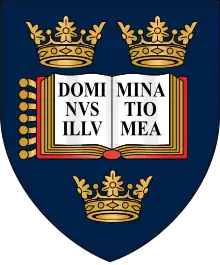St Edmund Hall, Oxford
St Edmund Hall (sometimes known as The Hall or affectionately as Teddy Hall) is a constituent college of the University of Oxford in England. The college has a claim to be "the oldest academical society for the education of undergraduates in any university" and was the last surviving medieval academic hall at the university.[4]
| St Edmund Hall | ||||||||||||
|---|---|---|---|---|---|---|---|---|---|---|---|---|
| Oxford | ||||||||||||
 | ||||||||||||
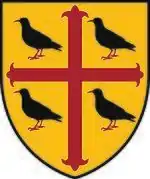 Arms: Or, a cross patonce gules cantoned by four Cornish choughs proper | ||||||||||||
| Location | The High / Queen's Lane | |||||||||||
| Coordinates | 51.753°N 1.25°W | |||||||||||
| Full name | St Edmund Hall in the University of Oxford | |||||||||||
| Latin name | Aula Sancti Edmundi | |||||||||||
| Established | c. 1278[1] | |||||||||||
| Named for | St Edmund of Abingdon | |||||||||||
| Sister college | Fitzwilliam College, Cambridge | |||||||||||
| Principal | Kathy Willis | |||||||||||
| Undergraduates | 376[2] | |||||||||||
| Postgraduates | 315[3] | |||||||||||
| Website | www | |||||||||||
| JCR | SEH JCR | |||||||||||
| MCR | SEH MCR | |||||||||||
| Boat club | SEH boatclub | |||||||||||
| Map | ||||||||||||
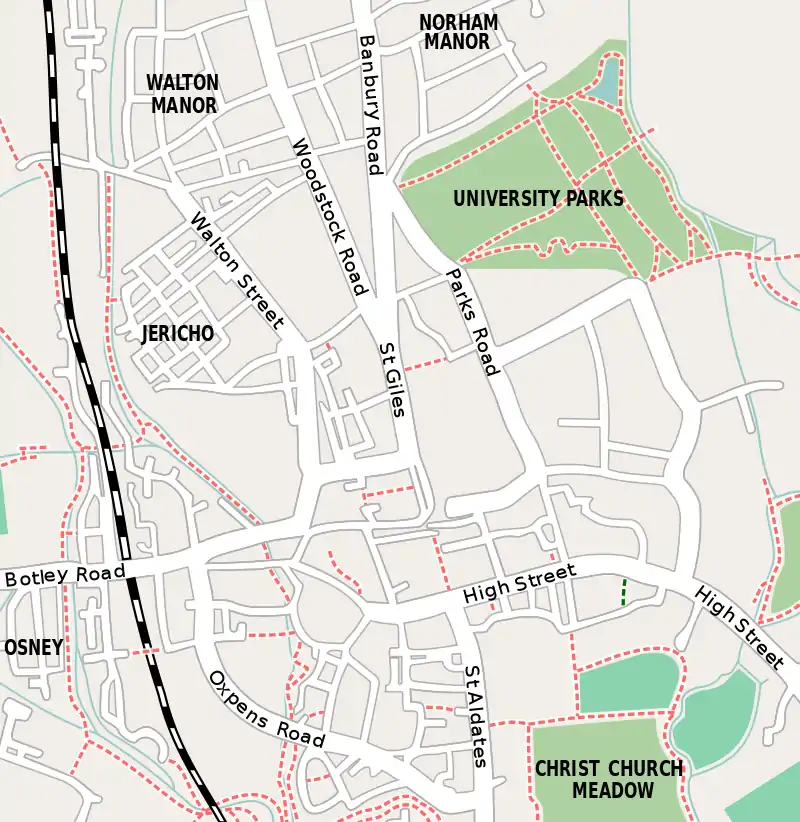 Location in Oxford city centre | ||||||||||||
The college is located just off Queen's Lane, near the High Street, in central Oxford. After more than seven centuries as a men-only college, it has been coeducational since 1979.[5]
As of 2019, the college had a financial endowment of more than £65 million.[6]
History

Similar to the University of Oxford itself, the precise date of establishment of St Edmund Hall is not certain; it is usually estimated at 1236, before any other college was formally established, though the founder from which the Hall takes its name, St Edmund of Abingdon, Oxfordshire, the first known Oxford Master of Arts and the first Oxford-educated Archbishop of Canterbury, lived and taught on the college site as early as the 1190s. The name St Edmund Hall (Aula Sancti Edmundi) first appears in a 1317 rental agreement.[7]
St Edmund Hall began life as one of Oxford's ancient Aularian houses, the medieval halls that laid the foundation of the University, preceding the creation of the first colleges. As the only surviving medieval hall, its members are known as "Aularians".
The college has a history of independent thought, which brought it into frequent conflict with both Church and State. During the late 14th and early 15th centuries it was a bastion of John Wycliffe's supporters, for which college principal William Taylor was ultimately burnt at the stake, and principal Peter Payne fled the country. In the late 17th century, St Edmund Hall incurred the wrath of the Crown for fostering non-jurors, men who remained loyal to the Scottish House of Stuart and who refused to take the oath to the German House of Hanover, whom they regarded as having usurped the British throne.[8]
In 1877 Prime Minister Disraeli appointed commissioners to consider and implement reform of the university and its colleges and halls.[9] The commissioners came to the view that the four remaining medieval halls were not viable and should merge with colleges on the death or resignation of the incumbent principals. [10] In 1881, the commissioners issued University Statutes which provided for a partial merger of St Edmund with Queen’s and for the other halls to merge with colleges.
In 1903 only St Edmund Hall remained. Principal Edward Moore wished to retire and become a resident canon in Canterbury Cathedral. Queen’s College proposed an amended statute for complete rather than partial merger, which was rejected by Congregation. In 1912 a statute was passed preserving the independence of the hall, which enabled Moore to retire.[11] Queen Elizabeth II approved St Edmund Hall's charter of incorporation as a full college of the University of Oxford in 1957, although it deliberately retained its ancient title of "Hall". The Duke of Edinburgh presented the royal charter to the college in June 1958.[5]
In 1978, women were first admitted as members of the Hall, with the first matriculations of women in 1979[5] and in 2015 the college celebrated the matriculation of its 3000th female student with events and exhibitions, including the display of portraits of notable women who had taught, studied or worked at the Hall in the Dining Hall, a noticeable change from the styles of portraits in most colleges.[12] Between 2015 and 2017, the proportion of UK undergraduates admitted to St Edmund Hall who were women was 42.3%.[13]
Buildings and grounds
St Edmund Hall is located in central Oxford, on the north side of the High Street, off Queen's Lane. It borders New College to the North and the Carrodus Quad of The Queen's College to the south.
The front quadrangle houses the porters' lodge, the Old Dining Hall, built in the 1650s, the college bar (the buttery), the chapel, the Old Library, offices and accommodation for students and Fellows.
Entrance
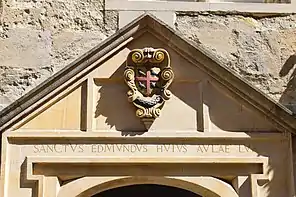
An engraving of the college coat of arms is found above the entrance to the college on Queen's Lane.
As seen in this image, the coat of arms sits above the following Latin dedication "sanctus edmundus huius aulae lux", or "St Edmund, light of this Hall".
It is a very common practice within the University to use chronograms for dedications. When transcribed into Latin, they are written in such a way that an important date, usually that of a foundation or the dedication itself, is embedded in the text in Roman numerals.
In the above dedication, the text is rendered as
sanCtVs edMVndVs hVIVs aVLae LVX
and, in this case, adding the numerals gives:
C + V + M + V + V + V + I + V + V + L + L + V + X = 1246
(For this reading one must disregard the usual "subtractive" convention — according to which, for example, "IV" would be 4, not 6.) The year 1246 is the date of the canonisation of St Edmund of Abingdon.
Well
In the centre of the quadrangle is a medieval well, which was uncovered in 1926 during the construction of a new lecture room and accommodation. This well is believed to be the original from which St Edmund himself drew water. A new wellhead was added, with the inscription "haurietis aquas in gaudio de fontibus salvatoris," Latin for "with joy, draw water from the wells of salvation." These words, from Isaiah 12:3, are believed to be those spoken by St Edmund on his deathbed at Salisbury. A metal grate was added to the well to prevent injuries, but water can still be seen in the well at a depth of about 9 feet. Plans to add a wooden frame and bucket were scrapped to maintain the overall appearance of the quad.
Chapel
The east side of the Front Quad contains the chapel. The chapel contains a stained glass window which is one of the earliest works by the artists Sir Edward Burne-Jones and William Morris, and a painting above the altar named Supper at Emmaus, by Ceri Richards. Often described as a 'marmite painting' due to its anachronous style within the chapel, which dates to the late 17th century, the painting commemorates the granting of the college's Royal Charter. The organ was built by Wood of Huddersfield in the 1980s. The St Edmund Hall Chapel Choir consists of eight choral scholars, two organ scholars and many other non-auditioning singers. The choir goes on two annual tours, including trips to Wells Cathedral in 2017, Pontigny, France, the burial place of St Edmund, in 2016 and Warsaw, Poland in 2015.
Old Library
Above the chapel is the Old Library. It was the last among Oxford colleges to chain its valuable books, but the first to have shelves against the walls. The Old Library is no longer the main library of the Hall, but is used for events and for research.
Library
The college library, the deconsecrated 12th century church of St Peter-in-the-East, was converted in the 1970s, and includes the 14th century tower, which houses a tutor's room at the top. The oldest part of the library still standing is the crypt below the church, which dates from the 1130s. The library is situated in the original churchyard of St Peter-in-the-East. 40,000 volumes are housed within it to cater to the wide variety of courses offered at the Hall. While many of the graves have been disinterred, several gravestones remain including one belonging to James Sadler, the first English aeronaut, and another which states the occupant died upon February 31. The garden contains a seated bronze sculpture of St Edmund as an impoverished student, made by Teddy Hall alumnus Rodney Munday.
Modern buildings
At the rear of the main site is a more modern area, which houses the dining hall, teaching facilities and undergraduate accommodation in the Kelly, Emden, Besse and Whitehall buildings. All first-year undergraduate students are guaranteed accommodation on the main site and many return for their third year after living out, usually in East Oxford, for the duration of their second year. The Wolfson Hall, the twentieth-century dining hall, seats approximately 230 people and is used by students on a daily basis for breakfast, lunch and dinner.
Annexes
The college also owns annexes at Norham Gardens, on Dawson Street and on Iffley Road.
The Norham Gardens annexe includes the Graduate Centre, a complex consisting of several large Victorian villas. This site was for many years the home of St Stephen's House, Oxford, before that institution moved to Iffley Road in 1980. The Norham Gardens annexe has the capacity to house most first year graduate students and has its own common room, IT facilities, gardens and gym. In addition to student rooms, the Graduate Centre also has a quantity of faculty housing.
The Dawson Street and Iffley Road annexes host undergraduates who do not live on the main site in pleasant en-suite, self-catering rooms.
Student life
As of 2017, the college has roughly 410 undergraduate, 300 graduate students and 75 Fellows, organised into three common rooms.[5] The Junior Common Room (JCR), for undergraduates, and Middle Common Room (MCR), for postgraduates, both organise regular events, including a Freshers' week programme, dinners and film nights. The college is reputed for the strength of its 'Hall Spirit' with the semi-finals and finals of sports competitions regularly attended by in excess of 70 supporters, remarkable for a college team. Over 250 were in attendance as the team won Football Cuppers in 2017. The atmosphere of the college is relaxed and welcoming, known for accommodating students of all and any kind.
Creative writing
Creative writing is a particular strength of St Edmund Hall. The college has a weekly creative writing workshop, a termly poetry reading series, an online writers' forum and The St Edmund Hall Gallery, the annual student arts and literary magazine.
The college runs an annual journalism competition for Oxford University students, in memory of alumnus and promising young journalist Philip Geddes, who died in the IRA bombing of Harrods in 1983. The college also hosts an annual lecture in his name.[14]
Drama
St Edmund Hall has a lively drama society, the John Oldham Society, which worked in Cameroon in 2013 on a community drama project.[15] In 2017-18 the College's entry into Drama Cuppers, the satirical 'Oswald French', written and starring Hugh Shepherd-Cross, reached the final round, and two students directed and produced a play called God of Carnage, which sold out its entire run at the Burton Taylor Studio.[16] In 2019-20 the John Oldham Society staged a production of The Importance of Being Earnest. The production sold out and was very well received, with the profits being donated to Stonewall.[16]
Music
The College has one of the largest non-auditioning College Choirs in Oxford, which is anchored by two Organ Scholars and eight Choral Scholars, under the direction of James Whitbourn, the Director of Music. The choir performs an evensong every Sunday and on special occasions, including the Feast Day of St Edmund and the popular 'Carols in the Quad' event at Christmas. The Choir take part in an annual exchange with Fitzwillam College, Cambridge, a UK residential (previous destinations have included Wells and Worcester Cathedrals), and visit Pontigny, France on tour each year to perform.
During Hilary term 2018 several events were held, including the Intercollegiate Evensong at the University Church; the joint service with the Hall’s sister college, Fitzwilliam College, Cambridge; and the joint Ash Wednesday service with University College. The term ended with an exploration of Lenten music through Buxtehude’s extraordinary cycle of cantatas: Membra Jesu Nostri. The Choir was joined by members of the world-class period instrument ensemble Instruments of Time & Truth for a powerful performance of the first three cantatas in the cycle.[16]
Sport
St Edmund Hall is known for its sporting excellence and participates in a large number of sports including rugby, football, rowing, tennis, cricket, mixed lacrosse, netball, hockey, swimming, and basketball, among others. Since becoming a college in 1957, the Men's Rugby Union team has won over half the Cuppers Tournaments it has ever entered (33 wins from 62 attempts). As a part of a team consisting of several colleges, Teddy Hall won women's rugby Cuppers in 2015–2016. In 2016–2017, St Edmund Hall won men's football and cricket Cuppers and its women's first boat and men's second boat won blades in Bumps. In 2017-2018 the College recorded victories in Men's Basketball (by 74-49 in the final), Swimming (for the third consecutive year), Men's Rugby, Women's Rugby (joint with Mansfield and Pembroke), Rounders (after an unbeaten season), and Pool.[17] Men's Rugby was won 20-17 over St Peter's College with an extra time drop goal. Cricket Cuppers was almost retained, with the team losing only in a Super Over after a historic tie. Finals were also reached by the Men's 2nd XI, the Mixed Hockey team, the Tennis Club, and the 2nd VII went unbeaten in their netball league.[17] Strong performances are also consistently recorded in men's and women's hockey, badminton and canoe polo.
The St Edmund Hall Boat Club also has a history of sporting success. The Boat Club held the men's headship in Summer Eights five times between 1959 and 1965 and women's headship from 2006 to 2009.[18] SEHBC had considerable success at the Henley Royal Regatta during its era of dominance in Oxford rowing in the 1960s.
- In 1958 an SEH coxless IV were the losing finalists in the Ladies' Challenge Plate, losing to Keble by 3 lengths.
- In 1959 a joint SEH/Lincoln College VIII won the Stewards' Challenge Cup, beating GS Moto Guzzi of Italy easily.
- In 1960 another joint SEH/Lincoln College VIII were the losing finalists in the Stewards' Challenge Cup, being beaten by Barn Cottage BC by 4 lengths.
- In 1961 an SEH coxless IV won the Visitors' Challenge Cup, beating St Catherine's College, Cambridge by 1½ lengths.
- In 1963 the 1st VIII were the losing finalists in the Ladies' Challenge Plate, losing to the Royal Military Academy Sandhurst by ½ length.
- In 1965, SEHBC had two victories; the 1st VIII won The Ladies' Challenge Plate, beating Jesus College, Cambridge by ¾ length, and an SEHBC coxless IV won the Visitors' Challenge Cup, beating Fitzwilliam House, Cambridge by 2 lengths.
The college celebrates the students’ successes in sports, arts and other extra-curricular activities at the annual Achievements Dinner. Cuppers winning teams are also rewarded with their photograph in the college bar, the walls of which are now crammed with teams dating from the late nineteenth century to the present day. The college also awards the Luddington Prize to undergraduate students who manage to achieve both a First Class degree in finals and a university Blue.
Outreach
The College has a very active outreach and access programme, employing two full-time staff and supported by a team of over 30 volunteer Student Ambassadors. Working with schools in the assigned link areas, including Leicestershire, Hampshire, the Isle of Wight and Peterborough, the College hosts visits from school groups and was one of the first colleges to take student ambassadors on an access roadshow. This saw four students and the Schools Liaison Officer visit nine schools in 4 days in Hampshire and the Isle of Wight in 2016 and continues to take place annually. The College since has expanded its provision to include a second roadshow in collaboration with Pembroke College, Cambridge, visiting schools and colleges in Leicestershire, which first took place in November 2018.
Formal Hall and college graces
The usual grace given before Formal Hall, as said by the fellow presiding at the dinner, is:
- Benedictus, Benedicat per Jesum Christum Dominum Nostrum
- (May he who is Blessed bless [this food] through Jesus Christ Our Lord)
The post cibum grace, given following pudding, is a slight variant on the above:
- Benedicto Benedicatur per Jesum Christum Dominum Nostrum
- (May the blessed one be blessed through Jesus Christ Our Lord)
To which the assembly responds Amen. More extended (or sung) forms of the grace are sometimes given but this is limited to special occasions, such the Feast of St Edmund, a formal held each year to commemorate the namesake of the hall.
The traditional college toast is occasionally also said at dinners, and is simply "Floreat Aula", Latin for "May the Hall Flourish".
People associated with the college
Notable alumni
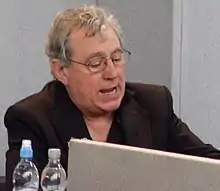




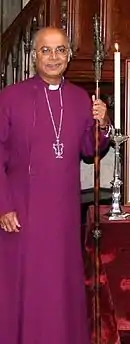 Bishop Michael Nazir-Ali
Bishop Michael Nazir-Ali_(cropped).jpg.webp)
Other notable figures
- St Edmund of Abingdon
- Jeremy Paxman, a Fellow of the College by Special Election.[20]
Principals
- 1405–1406 William Taylor, theologian, priest, excommunicated and executed as a Lollard
- 1410–1414 Peter Payne, theologian, diplomat, Lollard and Taborite
- 1565– Thomas Lancaster, Protestant clergyman, Church of Ireland Archbishop of Armagh
- 1610–1631 John Rawlinson, clergyman
- 1658–1676 Thomas Tully
- 1685–1707 John Mill, theologian
- 1751–1760 George Fothergill
- 1722–1740 Henry Felton, clergyman and academic
- 1740–1751 Thomas Shaw
- 1864–1903 Edward Moore
- 1913–1920 Henry Williams, Bishop of Carlisle (1920–1946)
- 1914–1918 Leonard Hodgson (Vice-Principal)
- 1920–1928 G.B. Allen
- 1928 George B. Cronshaw
- 1929–1951 Alfred Brotherston Emden
- 1951–1979 J.N.D. Kelly, clergyman
- 1979–1982 Sir Ieuan Maddock
- 1982–1996 J C B Gosling
- 1996–1998 Sir Stephen Tumim
- 1999–2009 Michael Mingos, Professor of Inorganic Chemistry
- 2009–2018 Keith Gull, FRS
- 2018–present Kathy Willis
Fellows
Gallery
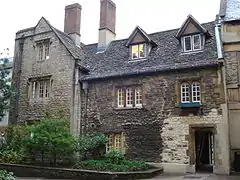 Rear of the buildings on the east side of the Front Quad as seen from the Wolfson Dining Hall
Rear of the buildings on the east side of the Front Quad as seen from the Wolfson Dining Hall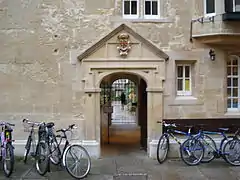 Front gate
Front gate.jpg.webp) College library
College library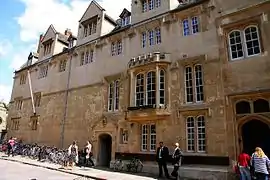 St Edmund Hall in Queens Lane
St Edmund Hall in Queens Lane
Notes
- University of Oxford (2008) St Edmund Hall - Admissions Archived December 24, 2008, at the Wayback Machine
- "St Edmund Hall". Retrieved 26 September 2020.
- "St Edmund Hall". Retrieved 26 September 2020.
- Cowdrey (1988); p. 388, referencing A.B. Emden who in his 1927 (p. 236) work states: "...and St Edmund Hall now survives as the last lineal descendent of the oldest form of academical society designed for the residence of scholars studying in the Oxford Schools."
- "About the College: Full History of the Hall". St Edmund Hall. Retrieved 31 July 2019.
- "St Edmund Hall : Annual Report and Financial Statements : Year ended 31 July 2019" (PDF). ox.ac.uk. p. 19. Retrieved 26 September 2020.
- Emden (1927), p. 60
- In both 1690 and 1692
- Brockliss 2016, pp. 364–365.
- Brockliss 2016, pp. 370–371.
- Salter, H. E.; Lobel, Mary D., eds. (1954). St. Edmund Hall. A History of the County of Oxford: Volume 3: The University of Oxford. Institute of Historical Research. pp. 319–335. Retrieved 9 December 2020.
- "Celebrating 3000 Women at St Edmund Hall". St Edmund Hall.
- "Annual Admissions Statistical Report 2018" (PDF). www.ox.ac.uk.
- Philip Geddes Memorial Fund website: "Archived copy". Archived from the original on 10 September 2011. Retrieved 1 August 2013.CS1 maint: archived copy as title (link)
- College website: http://www.seh.ox.ac.uk/news/acting-change-hall-students-cameroon-trip
- College Magazine: https://www.seh.ox.ac.uk/asset/SEH-Magazine-2018.pdf
- SEH Magazine 2018
- S.E.H. Men's Eights 1980-2016
- Zeffman, Henry (2 May 2020). "Kayleigh McEnany, the Oxford alumna who is Trump's new media warrior". The Times.
- "Visitor, Principal and Fellows". ox.ac.uk.
References
- Cowdrey, H.E.J. (1988) St Edmund Hall, Queen's Lane, In: Hibbert, C. (Ed.) The encyclopædia of Oxford, London : Macmillan, ISBN 0-333-39917-X, p. 388-391. Reproduced online by St Edmund Hall [accessed 1 June 2007, archived 22 July 2007]
- Emden, A.B. (1927) An Oxford Hall in Medieval Times: Being the Early History of St Edmund Hall, Oxford : Clarendon Press, Reprinted 1968
- Kelly, J.N.D. (1989) St Edmund Hall: Almost Seven Hundred Years, Oxford University Press, ISBN 0-19-951559-X
- Salter, H.E. and Lobel, M.D. (eds) [1954] (1994) "St. Edmund Hall", In: Victoria County History: A History of the County of Oxford: Volume 3: The University of Oxford, The Victoria History of the counties of England, Folkestone : Dawson for the University of London Institute of Historical Research, ISBN 0-7129-1064-6, p. 319-335.
External links
| Wikimedia Commons has media related to St Edmund Hall. |
- St Edmund Hall – official website
- St Edmund Hall JCR website
- St Edmund Hall MCR website
- St Edmund Hall Alternative Prospectus website
- Virtual tour of St Edmund Hall

